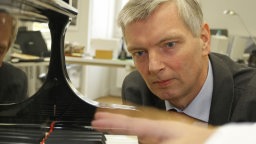What is Focal Dystonia?
Focal Dystonia, sometimes referred to as occupational or writer’s cramp, is a neurological disorder in which opposing muscles do not relax during muscular contraction. [1] You may recognize the term from the widely publicized case of pianist Leon Fleisher, who struggled with it for many years, and was forced to perform only repertoire for the left hand. Patients with the disorder usually experience muscle spasms or loss of motor function after constant, repetitive use of a specific area. The symptoms are typically triggered directly by the instigation of a particular occupation, such as writing or playing a musical instrument, and do not impact other activities. [2] According to a study by Jabusch & Altenmüller, approximately one percent of professional musicians develop focal dystonia during their careers. [3] Even though it is a rare condition for musicians, it is one of the most difficult to treat, and often has lasting consequences.
Symptoms
The first symptoms of focal dystonia are loss of motor function or control, followed by muscle cramping, fatigue, and stiffness in a particular area. [4] Musicians usually notice a decrease in the accuracy of their technique or an inability to perform specific passages. Pain is not a primary symptom. The dystonia is usually experienced in whichever part of the body is most overworked by the technique required to play their particular instrument. Pianists often experience it in their right hand, while string players may have trouble with either hand.
Other Factors
Perfectionist tendencies, increases in the difficulty level of repertoire or overall playing time, or increases in stress may contribute to the onset of this disorder. Focal dystonia is more common in professional musicians in their 30s or 40s who are at the height of their careers. [2] This may be because these musicians have been making the same, repetitive movements over a longer period of time, and have additional stressors and demands being placed on them, such as trying to balance the demands of a busy performance schedule.
Stay tuned for “Focal Dystonia in Musicians, Part 2,” which will discuss the treatment of this disorder.
References
[1] Dystonia Medical Research Foundation. (2006). Retrieved March 5, 2008, from http://www.dystonia-foundation.org.
[2] Brandfonbrener, A.G. (1995). Musicians with focal dystonia: a report of 58 cases seen during a ten-year period at a Performing Arts Medicine clinic. Medical Problems of Performing Artists, 10(4), 121-127.
[3] Jabusch H-C, & Altenmüller, E. (2006). Focal dystonia in musicians: from phenomenology to therapy. Advanced Cognitive Psychology, 2 (2-3), 207-220.
[4] Lederman, R.J. (1998). Neurological Problems of Performing Artists. In R.T. Sataloff, A.G. Brandfonbrener, & R.J. Lederman (Eds.). Performing Arts Medicine (2nd Ed., pp. 47-71). San Diego: Singular Publishing.















No comments yet.